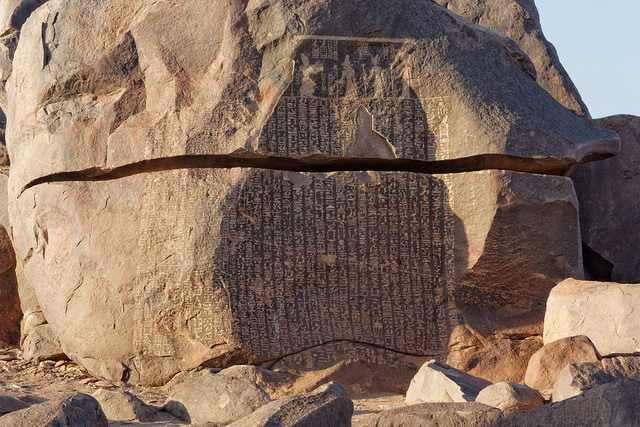Nestled along the banks of the Nile River near Aswan, Egypt, stands a remarkable artifact that has captivated the attention of historians and Egyptologists for decades – the Famine Stela. This ancient Egyptian hieroglyphic inscription recounts a period of devastating drought and famine that plagued the land during the reign of Pharaoh Djoser, providing a unique window into the religious beliefs, struggles, and quest for divine intervention in the Old Kingdom.
Uncovering the Famine Stela’s Secrets

The Famine Stela is a rectangular-shaped granite block, measuring approximately 1.5 meters in height and 0.8 meters in width. Carved into its surface are 32 columns of hieroglyphic text, accompanied by a depiction of Pharaoh Djoser offering supplications to three prominent Egyptian deities – Khnum, Satis, and Anuket.
One of the most intriguing features of the Famine Stela is a prominent horizontal crack that runs through the middle of the rock, which existed even before the inscription was carved. This crack has caused some sections of the text to be damaged over time, rendering a few passages unreadable. Nonetheless, the remaining text provides a captivating narrative that has captured the imagination of scholars and enthusiasts alike.
The Story of the Famine and Pharaoh Djoser’s Quest
The Famine Stela’s narrative transports us to the 18th year of Pharaoh Djoser’s reign, a time when Egypt was gripped by a devastating seven-year drought. The Nile, the lifeblood of the ancient Egyptian civilization, had failed to flood the farmlands, leading to widespread famine and suffering among the people.

Amidst this crisis, Pharaoh Djoser turned to his trusted high lector priest, Imhotep, for guidance. Imhotep embarked on a journey to uncover the source of the Nile’s failure, eventually discovering that the god Khnum, who resided on Elephantine Island, was responsible for regulating the Nile’s flooding. Through a remarkable dream, Imhotep received a divine message from Khnum, who promised to restore the flow of the river.
Overjoyed by this revelation, Pharaoh Djoser issued a decree, commanding the restoration of Khnum’s temple and the resumption of regular offerings to the god. Furthermore, Djoser granted the region between Aswan and Tachompso, along with its wealth and a share of Nubian imports, to the temple of Khnum at Elephantine.
The Significance of the Famine Stela
The Famine Stela has been the subject of extensive study and analysis by historians and Egyptologists. Scholars believe the inscription was likely created during the Ptolemaic period, possibly during the reign of King Ptolemy V (205 – 180 BC), as the language and layout suggest a later date than the Old Kingdom era it describes.
One of the most intriguing aspects of the Famine Stela is its connection to other cultural narratives of the ancient Near East, including the biblical story of the seven-year famine in the book of Genesis and a Mesopotamian legend. This shared theme of a prolonged drought and famine suggests the widespread impact of such natural disasters in the ancient world and the universal human need for divine intervention.
Moreover, the Famine Stela provides valuable evidence for Egyptologists by combining the cartouche name “Djeser” (“lordly”) with the serekh name “Netjerikhet” (“divine body”) of Pharaoh Djoser in a single word. This discovery has aided in the reconstruction of the royal chronology of the Old Kingdom, further enhancing our understanding of ancient Egyptian history.
The Enduring Legacy of the Famine Stela

The Famine Stela stands as a testament to the resilience and faith of the ancient Egyptians in the face of natural disasters. Its detailed narrative and historical significance continue to captivate scholars and enthusiasts alike, offering a glimpse into the complex relationship between the Pharaoh, the gods, and the people.
By studying and deciphering the Famine Stela, we deepen our understanding of the challenges faced by ancient Egyptian civilization and the role of religion and divine intervention in shaping their responses to crisis. This ancient inscription serves as a powerful reminder of the enduring human need for hope and the capacity to overcome even the most daunting of adversities.
As we delve into the rich tapestry of ancient Egyptian history, the Famine Stela stands as a captivating and invaluable artifact, inviting us to explore the depths of this remarkable civilization and the timeless lessons it has to offer.
